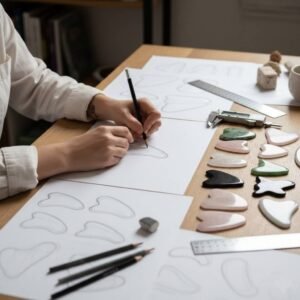
Gua Sha, a massage technique that uses specialized tools to apply pressure to the skin, has become increasingly popular thanks to social media. On Tiktok, for example, the Gua Sha hashtag has accumulated nearly 1 billion views to date.
Gua Sha is popular because of its ability to improve blood circulation and reduce facial puffiness. Hence the name Gua Sha, and “Sha” means sand, referring to the occasional red spots on the skin later on.
Here’s what you should know about Gua Sha and its purported benefits.
What is Facial Gua Sha Stone?
Gua Sha is a traditional Chinese healing technique in which a special jade or quartz tool is used to scrape the skin with rounded and smooth edges. It is designed to dilate or burst capillaries and, depending on the amount of pressure applied, produces tiny red spots called petechiae. These spots are only temporary and last from a few hours to a few days.
Gua Sha was originally used on the body, such as the arms, legs and back, but is now commonly used to improve the appearance of the face. According to the classics of traditional Chinese medicine, the effects of gua sha are:
- Chronic pain relief
- Promotes lymphatic drainage, which reduces swelling by promoting the flow of lymph, a fluid that transports white blood cells and clears bacteria and viruses.
Face Gua Sha Useful?

Today, Gua Sha is commonly used to sculpt the face and reduce wrinkles. However, almost all of these claims are anecdotal, with little scientific evidence to support them.
Research to date suggests that scraping may:
- Improves blood flow in the treated area: A small 2007 study found that Gua Sha can improve microcirculation, which is blood circulation in small blood vessels, for about 25 minutes after treatment.
- Reduce puffiness: Gently stroking or exercising on the face helps keep lymph fluid flowing, which may reduce Puffiness and inflammation.
- Wrinkle reduction: A 2023 case study found that scraping can improve wrinkles and fine lines, but more research is needed to further investigate this benefit.
While gua sha may improve the appearance of the skin, the effects are usually temporary, Garshick said. For example, your cheekbones may look more sculpted after gua sha, but usually swell again the next morning. That’s because when you lie down to sleep, water can build up on your face and cause slight swelling due to gravity.
In addition to skin care, several small studies have found potential benefits of gua sha, such as treating conditions such as migraines, chronic neck pain, Tourette’s syndrome, and perimenopause.
How to Use Gua Sha Stone?

To use Gua Sha, simply slide one of the tools over the skin’s smooth edges twice, applying gentle pressure as you go. Before using the tool, you can apply a cream or serum to the area to help it glide more smoothly.
However, those with sensitive skin may prefer to avoid [gua sha], as applying too much pressure may lead to potential skin irritation. While the side effects are minimal, it can be uncomfortable and cause bruising or soreness if the pressure is applied. Refer to the following 7 points:
- Neck: Starting at the right collarbone, sweep the broad side of the tool up to the jawline while applying moderate pressure, then repeat on the other side. Do each step twice before proceeding to the next step.
- Throat: Put the tool between the collarbones, sweep to the chin and gently massage the throat. You can use one of wide or curved sides.
- Chin: Starting at the center of the chin, move the curved side of the tool along the jaw line until it reaches the bottom of the ear. Repeat on the other side.
- Cheek: Place the flat broad side of the tool on the right side of the mouth. Slowly drag it up over the cheekbones and stop just before reaching the ears. Repeat on the other side.
- Eyes: Starting under the inner corner of the right eye, gently move the narrow edge of the tool under the eye and toward the hairline. Repeat on the other side.
- Eyebrows: Place the tool in the middle of the eyebrows and sweep to the right until you reach the hairline. Repeat on the other side.
- Forehead: Starting at the top of the right eyebrow, drag the wide side of the tool to the top of the hairline. Repeat this movement from the middle of the eyebrow to the top of the left eyebrow.
You can incorporate a routine into your skincare regimen once a week or more frequently, depending on your tolerance for the technique.
Additional Supplements for Professionals
Gua Sha is a traditional Chinese technique that involves stroking the face or other parts of the body, using smooth tools to improve blood circulation and promote lymph flow.
The idea behind better circulation and lymph flow is that it reduces puffiness and minimizes wrinkles on the face, but larger studies are needed to confirm these benefits.
However, it is safe to try Gua Sha at home as long as you are not taking blood thinners. If you’re looking for maximum results, try Gua Sha in the morning when you’re most puffy. Remember not to apply too much pressure or you may irritate the skin.
Gua Sha Usage Faqs
1. Does Gua Sha Really Work?
Yes, scraping therapy is effective. Numerous user experiences have shown that scraping therapy can indeed be effective for specific symptoms. However, don’t over-mythologize it. Always follow a doctor’s advice before performing guasha therapy (For the purpose of curing diseases).
2. Is Gua Sha Effective Scientifically?
Gua Sha has certain scientific theories, but there is still a lack of sufficient research data.






